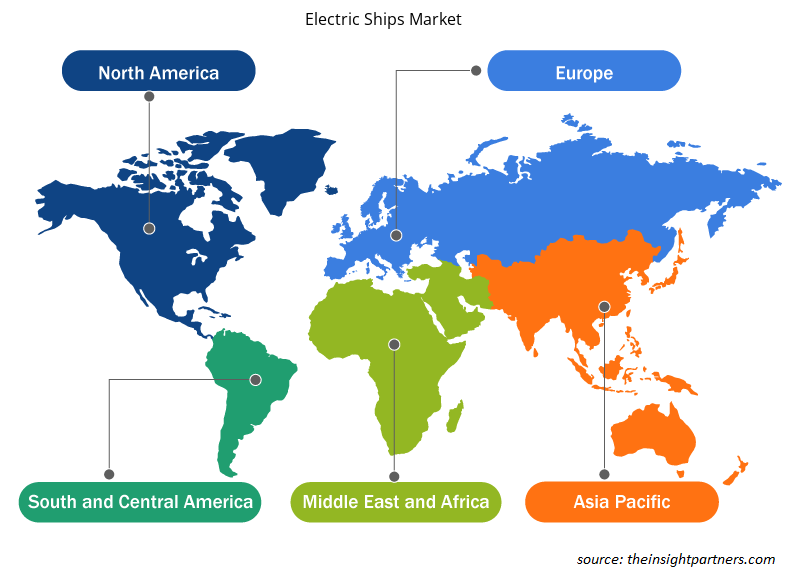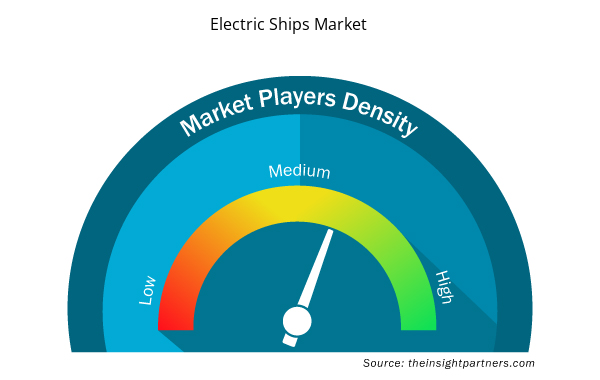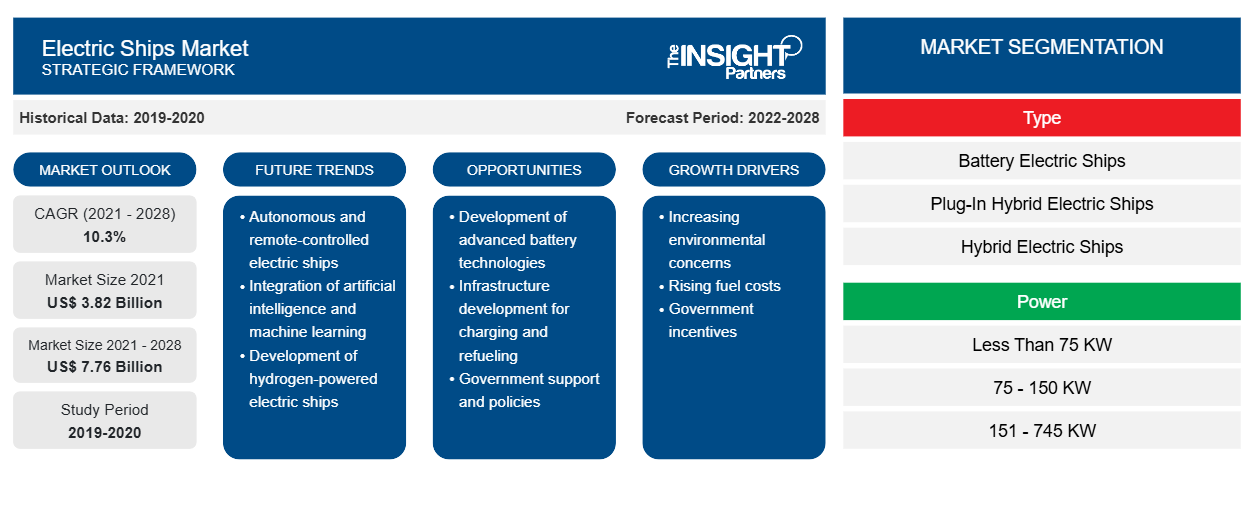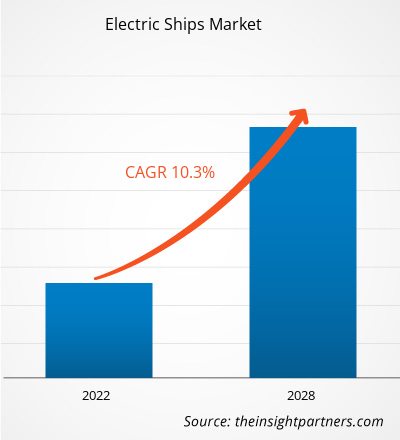전기선박 시장 규모는 2021년에 38억 2천만 달러에 달했으며, 2021년부터 2028년까지 연평균 성장률 10.3%로 성장할 것으로 추산됩니다.
전기 보트는 주요 추진 기술이 전기 구동 시스템인 보트 또는 선박입니다. 이는 풀 배터리 전기, 수소 연료 전지 전기 , 전기 하이브리드 보트 또는 선박일 수 있으며, 예인선, 페리, 화물선 및 바지선에서 투어 보트, 어선, 크루징 요트 및 무인 수중 차량(UUV)에 이르기까지 다양합니다. 전기 선박은 기존 디젤 엔진 선박과 달리 전기로 구동됩니다. 이러한 선박은 배터리 저장 장치를 전원으로 사용하여 전기 모터를 구동합니다. 리튬 이온 배터리, 납산 배터리 및 연료 전지를 포함하여 다양한 유형의 배터리를 전기 선박에서 사용할 수 있습니다. 전기 선박은 주로 페리와 내륙 수로의 소형 여객선으로 전적으로 전기로 항해합니다. 단 한 번 충전으로 약 80km로 짧은 거리만 이동합니다. 또한 태양열 선박은 저전력 출력이 필요한 경량 선박에도 사용됩니다. 그러나 화물선의 전력 요구 사항은 중량으로 인해 완전 전기 시스템으로는 충족할 수 없으므로 화물선은 하이브리드 디젤-전기 시스템을 활용하고 있습니다.
귀하의 요구 사항에 맞게 이 보고서를 사용자 정의하세요
이 보고서의 일부 또는 국가 수준 분석, Excel 데이터 팩을 포함하여 모든 보고서에 대한 사용자 정의를 무료로 받을 수 있으며 신생 기업 및 대학을 위한 훌륭한 혜택과 할인 혜택을 이용할 수 있습니다.
- 이 보고서의 주요 시장 동향을 알아보세요.이 무료 샘플에는 시장 동향부터 추정 및 예측까지 다양한 데이터 분석이 포함됩니다.
COVID-19 팬데믹이 전기선박 시장에 미치는 영향
COVID-19 팬데믹은 전기 선박 시장에 부정적인 영향을 미쳤습니다 . 이 팬데믹은 인간의 이동성에 전례 없는 세계적 영향을 미쳤습니다. 바다에서는 인간의 이동에 대한 심각한 제한과 상품 소비의 변화로 인해 선박 기반 활동이 영향을 받습니다. 일부 국가는 COVID-19 팬데믹으로 인해 크루즈 산업을 폐쇄했습니다. 그러나 일부 크루즈 노선은 팬데믹 동안 활동을 재개하려고 노력하고 있습니다. 바다에서의 인간 활동은 COVID-19 팬데믹으로 인해 근본적으로 바뀌었으며, 항구 제한과 소비 패턴의 변화가 여러 해양 부문, 어업, 여객 페리 및 크루즈 선박에 영향을 미쳤다는 보고가 있습니다. 그러나 일부 지역에서는 봉쇄 기간 동안 상품 운송이 필수적이라고 선언되어 전기 선박 시장에 수익성 있는 기회가 생겼습니다.
전기선박 시장 통찰력
선박 개조를 위한 하이브리드 및 전기 추진 시스템 채택 증가
선박 개조에 대한 관심이 높아지고 있으며, 선주/조선사가 기존 선박의 수명을 연장하고자 합니다. 이러한 프로세스는 연료 소비를 줄이고 비용 효율적인 절차로서 최신 친환경 솔루션에 대한 최신 정보를 얻을 수 있는 기회를 제공합니다. 개조는 해운 산업에서 일반적인 관행이 되고 있습니다. 조선소는 자동화를 향해 나아가고 있으며, 새로 건조한 선박을 통합하고 기존 선박을 하이브리드 및 전기 추진 시스템으로 개조하고 있습니다. 이 시스템은 페리, 컨테이너선, 크루즈선, 예인선 및 일반 화물선을 포함하여 엄청난 개조 잠재력이 있는 오래된 선박을 개조하는 데 편리한 선택입니다. 조선소는 새로운 선박을 구매하는 것보다 비교적 저렴한 옵션이기 때문에 하이브리드 전기 추진 시스템 또는 완전 전기 추진 시스템으로 선박을 개조하기로 선택합니다. 또한 여러 유럽 조선소는 현재 선박 함대를 하이브리드 및 전기 추진 시스템으로 적극적으로 개조하고 있습니다. 예를 들어, Riviera Maritime Media Ltd가 2020년 3월에 발행한 기사에 따르면, 해상 공급선(OSV) 소유주는 디젤-전기/LNG 구동 함대를 배터리-하이브리드 추진으로 개조하는 데 투자했으며, 이는 전세인, 소유주 및 노르웨이의 환경 문제에 이익이 되는 조치입니다. 이러한 요인으로 인해 개조 선박에 하이브리드 및 전기 추진 시스템이 도입되었습니다.
유형 기반 시장 통찰력
전기선 시장은 유형에 따라 배터리 전기선, 플러그인 하이브리드 전기선, 하이브리드 전기선으로 구분됩니다. 하이브리드 전기선 부문은 2020년 시장을 선도했습니다. 하이브리드 전기선이 제공하는 신뢰성은 보조 추진 시스템과 더 빠른 속도를 사용하여 고장 위험을 줄이고 더 짧은 시간에 더 먼 거리를 이동할 수 있기 때문에 수요를 뒷받침합니다. 게다가 하이브리드 전기선 추진은 전기(디젤 전기 또는 배터리 전원 구동) 또는 기계(직접 디젤 구동)의 두 가지 방식으로 추진할 수 있습니다. 더욱이 전 세계의 선박 소유주 또는 해운 및 물류 회사는 연료 소비를 줄이고 운영 비용을 절감할 수 있기 때문에 하이브리드 전기선을 선호합니다. 저전력에서 디젤 전기 추진을 사용하고 속도 조건이 다른 내륙 수역에서 높은 전력이 필요한 경우 직접 디젤 구동 추진을 사용하면 전기선의 운영 비용을 줄일 수 있습니다. 이는 하이브리드 전기선 추진을 사용하여 사용 가능한 에너지를 사용하고 연료 비용을 절감하는 더 스마트한 방법입니다.
전기선 시장에서 활동하는 업체들은 합병, 인수, 시장 이니셔티브와 같은 전략을 채택하여 시장에서의 입지를 유지합니다. 주요 업체들의 몇 가지 개발 사항은 아래에 나와 있습니다.
- 2021년 11월, BAE Systems는 해양 운영자가 제로 배출을 달성할 수 있도록 돕는 차세대 전력 및 추진 시스템을 출시했습니다. 이는 전기 효율성과 선박 범위를 개선하고 추진력을 높이며 설치를 간소화하는 유연한 솔루션을 제공합니다.
- 2020년 9월, 콜럼버스(모빌리티 회사)와 피엘스트란드(조선소)는 세계 최초의 완전 전기 고속 페리를 인도하는 계약을 체결했습니다. 이 프로젝트는 유럽 연합의 Horizon 2020 연구 및 혁신 프로그램에서 자금을 지원받았습니다.
전기선 시장은 유형에 따라 배터리 전기선, 플러그인 하이브리드 전기선, 하이브리드 전기선으로 구분됩니다. 전기선 시장은 전력에 따라 75kW 미만, 75~150kW, 151~745kW, 746~7560kW, 7560kW 이상으로 구분됩니다. 범위에 따라 전기선 시장은 50km 미만, 50~100km, 101~1000km, 1000km 이상으로 분류됩니다. 선박 유형에 따라 전기선 시장은 크루즈선, 페리, 유조선, 벌크선, 어선, 구축함, 항공모함 등으로 구분됩니다. 지리적으로 전기선 시장은 북미, 유럽, 아시아 태평양(APAC), 중동 및 아프리카(MEA), 남미(SAM)의 5개 주요 지역으로 구분됩니다.
전기선박 시장 지역 통찰력
Insight Partners의 분석가들은 예측 기간 동안 전기선 시장에 영향을 미치는 지역적 추세와 요인을 철저히 설명했습니다. 이 섹션에서는 북미, 유럽, 아시아 태평양, 중동 및 아프리카, 남미 및 중미의 전기선 시장 세그먼트와 지리에 대해서도 설명합니다.

- 전기선박 시장에 대한 지역별 특정 데이터 얻기
전기선박 시장 보고서 범위
| 보고서 속성 | 세부 |
|---|---|
| 2021년 시장 규모 | 38억 2천만 달러 |
| 2028년까지 시장 규모 | 77억 6천만 달러 |
| 글로벌 CAGR (2021-2028) | 10.3% |
| 역사적 데이터 | 2019-2020 |
| 예측 기간 | 2022-2028 |
| 다루는 세그먼트 | 유형별로
|
| 포함된 지역 및 국가 | 북아메리카
|
| 시장 선도 기업 및 주요 회사 프로필 |
|
전기선박 시장 참여자 밀도: 비즈니스 역학에 미치는 영향 이해
전기선박 시장은 소비자 선호도의 변화, 기술 발전, 제품의 이점에 대한 인식 증가와 같은 요인으로 인해 최종 사용자 수요가 증가함에 따라 빠르게 성장하고 있습니다. 수요가 증가함에 따라 기업은 제품을 확장하고, 소비자의 요구를 충족하기 위해 혁신하고, 새로운 트렌드를 활용하여 시장 성장을 더욱 촉진하고 있습니다.
시장 참여자 밀도는 특정 시장이나 산업 내에서 운영되는 회사나 기업의 분포를 말합니다. 주어진 시장 공간에 얼마나 많은 경쟁자(시장 참여자)가 존재하는지 그 규모나 전체 시장 가치에 비해 나타냅니다.
전기선박 시장에서 운영되는 주요 회사는 다음과 같습니다.
- BAE 시스템
- 더피 일렉트릭 보트 회사
- 펠스트란드 AS
- 엑스 쇼어
- 제너럴 다이내믹 일렉트릭 보트
면책 조항 : 위에 나열된 회사는 어떤 특별한 순서에 따라 순위가 매겨지지 않았습니다.

- 전기선박 시장 주요 주요 업체 개요를 알아보세요
회사 프로필
- BAE 시스템
- 더피 일렉트릭 보트 컴퍼니
- 펠스트란드 AS
- 엑스 쇼어
- 제너럴 다이내믹 일렉트릭 보트
- 후르티그루텐
- MAN 에너지 솔루션
- 포트라이너
- 지멘스 에너지
- 바르드 AS
- 역사적 분석(2년), 기준 연도, CAGR을 포함한 예측(7년)
- PEST 및 SWOT 분석
- 시장 규모 가치/양 - 글로벌, 지역, 국가
- 산업 및 경쟁 환경
- Excel 데이터 세트



Report Coverage
Revenue forecast, Company Analysis, Industry landscape, Growth factors, and Trends

Segment Covered
This text is related
to segments covered.

Regional Scope
North America, Europe, Asia Pacific, Middle East & Africa, South & Central America

Country Scope
This text is related
to country scope.
자주 묻는 질문
The idea of retrofitting ships is gaining interest and is attracting shipowners/shipbuilders to extend the lifetime of their existing ships. Such a process provides a chance to reduce fuel consumption and stay up to date with the latest eco-friendly solutions as a cost-effective procedure. Retrofitting is becoming a common practice in the maritime industry. Shipbuilders are moving toward automation, integrating new build ships, and retrofitting existing ships with hybrid and electric propulsion systems. A hybrid-electric propulsion system is a convenient choice for retrofitting outdated ships. Ships have a large retrofit potential, including ferries, container vessels, cruise ships, tugboats, and general cargo ships. Shipbuilders choose to retrofit ships with a hybrid-electric propulsion system or a fully electric propulsion system as it is a relatively cheaper option than purchasing a new ship. These factors mentioned above have resulted in the adoption of hybrid and electric propulsion systems for retrofitting ships.
Nowadays, hybrid propulsion technology is commonly used for small vessels such as ferries. For instance, according to the article published by the Institution of Engineering and Technology, in January 2019, the UK shipbuilder Ferguson Marine had built Catriona, a £12.3 million (US$ 15.82 million) diesel-electric-battery-power hybrid ferry for CalMac to use on its Clyde and Hebridean routes. However, with the development of marine electric propulsion technology and alternative fuels such as fuel cells, there is a massive opportunity for manufacturers to work on hybrid-electric propulsion systems for larger ships. The stricter emissions targets have encouraged shipbuilders to install a hybrid propulsion system on existing or new vessels. The research & development (R&D) department for ABB marine activities in Norway stated that the hybrid propulsion systems significantly reduce both fuel consumption and emissions, according to the article published by the Institution of Engineering and Technology in January 2019. Therefore, with the growing emission control norms, the adoption of hybrid-electric propulsion systems is increasing among larger ships, creating a massive opportunity for manufacturing larger ships using hybrid-electric propulsion systems.
Europe dominated the Electric Ships market in 2020 with a share of 48.6% and is expected to continue its dominance by 2028. North America is the second-largest contributor to the global Electric Ships market in 2020, followed by Asia Pacific.
The major companies in Electric Ships market are BAE Systems, Duffy Electric Boat Company, Fjellstrand AS, X Shore, General Dynamic Electric Boat, Hurtigruten, MAN Energy Solutions, PortLiner, Siemens Energy, and VARD AS
The major Application in Electric Ships includes cruise ship, ferries, tankers, bulk carriers, fishing vessels, destroyers, aircraft carriers, and others. In terms of market share, the electric ships market was dominated by the ferries segment in 2020.
The electric ships market, by type is segmented into battery electric ships, plug-in hybrid electric ships, and hybrid electric ships. The Electric Ships market was dominated by the hybrid electric ships segment in 2020.
Trends and growth analysis reports related to Automotive and Transportation : READ MORE..
The List of Companies - Electric Ships Market
- BAE Systems
- Duffy Electric Boat Company
- Fjellstrand AS
- X Shore
- General Dynamic Electric Boat
- Hurtigruten
- MAN Energy Solutions
- PortLiner
- Siemens Energy
- VARD AS
The Insight Partners performs research in 4 major stages: Data Collection & Secondary Research, Primary Research, Data Analysis and Data Triangulation & Final Review.
- Data Collection and Secondary Research:
As a market research and consulting firm operating from a decade, we have published and advised several client across the globe. First step for any study will start with an assessment of currently available data and insights from existing reports. Further, historical and current market information is collected from Investor Presentations, Annual Reports, SEC Filings, etc., and other information related to company’s performance and market positioning are gathered from Paid Databases (Factiva, Hoovers, and Reuters) and various other publications available in public domain.
Several associations trade associates, technical forums, institutes, societies and organization are accessed to gain technical as well as market related insights through their publications such as research papers, blogs and press releases related to the studies are referred to get cues about the market. Further, white papers, journals, magazines, and other news articles published in last 3 years are scrutinized and analyzed to understand the current market trends.
- Primary Research:
The primarily interview analysis comprise of data obtained from industry participants interview and answers to survey questions gathered by in-house primary team.
For primary research, interviews are conducted with industry experts/CEOs/Marketing Managers/VPs/Subject Matter Experts from both demand and supply side to get a 360-degree view of the market. The primary team conducts several interviews based on the complexity of the markets to understand the various market trends and dynamics which makes research more credible and precise.
A typical research interview fulfils the following functions:
- Provides first-hand information on the market size, market trends, growth trends, competitive landscape, and outlook
- Validates and strengthens in-house secondary research findings
- Develops the analysis team’s expertise and market understanding
Primary research involves email interactions and telephone interviews for each market, category, segment, and sub-segment across geographies. The participants who typically take part in such a process include, but are not limited to:
- Industry participants: VPs, business development managers, market intelligence managers and national sales managers
- Outside experts: Valuation experts, research analysts and key opinion leaders specializing in the electronics and semiconductor industry.
Below is the breakup of our primary respondents by company, designation, and region:

Once we receive the confirmation from primary research sources or primary respondents, we finalize the base year market estimation and forecast the data as per the macroeconomic and microeconomic factors assessed during data collection.
- Data Analysis:
Once data is validated through both secondary as well as primary respondents, we finalize the market estimations by hypothesis formulation and factor analysis at regional and country level.
- Macro-Economic Factor Analysis:
We analyse macroeconomic indicators such the gross domestic product (GDP), increase in the demand for goods and services across industries, technological advancement, regional economic growth, governmental policies, the influence of COVID-19, PEST analysis, and other aspects. This analysis aids in setting benchmarks for various nations/regions and approximating market splits. Additionally, the general trend of the aforementioned components aid in determining the market's development possibilities.
- Country Level Data:
Various factors that are especially aligned to the country are taken into account to determine the market size for a certain area and country, including the presence of vendors, such as headquarters and offices, the country's GDP, demand patterns, and industry growth. To comprehend the market dynamics for the nation, a number of growth variables, inhibitors, application areas, and current market trends are researched. The aforementioned elements aid in determining the country's overall market's growth potential.
- Company Profile:
The “Table of Contents” is formulated by listing and analyzing more than 25 - 30 companies operating in the market ecosystem across geographies. However, we profile only 10 companies as a standard practice in our syndicate reports. These 10 companies comprise leading, emerging, and regional players. Nonetheless, our analysis is not restricted to the 10 listed companies, we also analyze other companies present in the market to develop a holistic view and understand the prevailing trends. The “Company Profiles” section in the report covers key facts, business description, products & services, financial information, SWOT analysis, and key developments. The financial information presented is extracted from the annual reports and official documents of the publicly listed companies. Upon collecting the information for the sections of respective companies, we verify them via various primary sources and then compile the data in respective company profiles. The company level information helps us in deriving the base number as well as in forecasting the market size.
- Developing Base Number:
Aggregation of sales statistics (2020-2022) and macro-economic factor, and other secondary and primary research insights are utilized to arrive at base number and related market shares for 2022. The data gaps are identified in this step and relevant market data is analyzed, collected from paid primary interviews or databases. On finalizing the base year market size, forecasts are developed on the basis of macro-economic, industry and market growth factors and company level analysis.
- Data Triangulation and Final Review:
The market findings and base year market size calculations are validated from supply as well as demand side. Demand side validations are based on macro-economic factor analysis and benchmarks for respective regions and countries. In case of supply side validations, revenues of major companies are estimated (in case not available) based on industry benchmark, approximate number of employees, product portfolio, and primary interviews revenues are gathered. Further revenue from target product/service segment is assessed to avoid overshooting of market statistics. In case of heavy deviations between supply and demand side values, all thes steps are repeated to achieve synchronization.
We follow an iterative model, wherein we share our research findings with Subject Matter Experts (SME’s) and Key Opinion Leaders (KOLs) until consensus view of the market is not formulated – this model negates any drastic deviation in the opinions of experts. Only validated and universally acceptable research findings are quoted in our reports.
We have important check points that we use to validate our research findings – which we call – data triangulation, where we validate the information, we generate from secondary sources with primary interviews and then we re-validate with our internal data bases and Subject matter experts. This comprehensive model enables us to deliver high quality, reliable data in shortest possible time.


 이 보고서에 대한 무료 샘플을 받으세요
이 보고서에 대한 무료 샘플을 받으세요